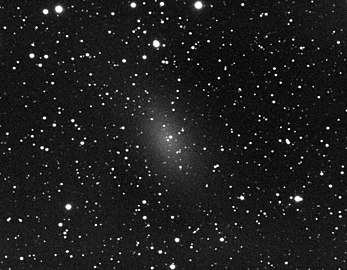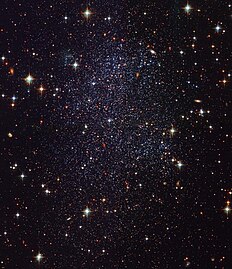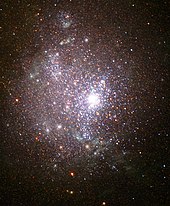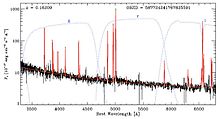Dwarf galaxy
Dwarf galaxies are extragalactic star systems that lie between the smaller globular clusters and the larger "normal" galaxies . In general, it is now assumed that there are no fundamental differences between “normal” galaxies and dwarf galaxies as systems and that their properties make a continuous transition between them.
While the surface brightness of the dwarf galaxies (i.e. luminosity density ) also decreases with decreasing absolute brightness, the surface brightness of the large elliptical galaxies decreases as the absolute brightness increases. Criteria such as the absolute brightness , the surface brightness , the half-light radius , the diameter, the mass or the number of stars serve the goals and requirements of the respective investigation.
Occurrence
Dwarf galaxies are found as satellites of large galaxies, as in the case of the Magellanic Clouds in the Milky Way . They can be found both in the walls of the gigantic empty spaces of the universe - there mostly irregular dwarf galaxies - and especially often in groups of galaxies and galaxy clusters - there, elliptical dwarf galaxies dominate.
Dwarf galaxies are significantly more common - roughly a factor of 10 - than the large galaxies. However, they are more difficult to observe at greater distances and because of their low surface brightness.
Well-known - because relatively bright - examples are the two companions M 32 and M 110 of the Andromeda Galaxy or the Sagittarius dwarf galaxy , which belong to the 24 known dwarf galaxies that orbit the Milky Way .
The Local Group currently has at least 67 known dwarf galaxies among its members. It is to be expected that further dwarf galaxies will also be found in the local group. For example, the closest dwarf galaxy, the Canis Major dwarf galaxy , was not discovered until 2003. With dwarf galaxies, which are very close to the Milky Way, it is often difficult to distinguish the galaxy from the foreground of the Milky Way. Another example of a very close and difficult to observe dwarf galaxy is the Draco dwarf galaxy .
properties
morphology
Morphologically , dwarf galaxies are divided according to their shape into
- elliptical (dE),
- spheroidale (dSph) and
- irregular (dIrr) dwarf galaxies,
- as well as the relatively rare dwarf spiral galaxies (dS)
The Antlia dwarf galaxy , a typical elliptical dwarf galaxy
NGC 147 , a typical dwarf spheroidal galaxy
The Sagittarius Irregular Dwarf Galaxy , a typical irregular dwarf galaxy
NGC 5474 , one of the rare dwarf spiral galaxies
Elliptical and spheroidal dwarf galaxies are also grouped together as early morphological types, the irregular and spiral dwarf galaxies as later morphological types. The early types currently no longer show star formation, while the appearance of the later types is often dominated by massive, young stars. During their development, however, even with the dwarf galaxies of early morphological types, there were sometimes several phases of star formation.
composition
The gas and dust content in dwarf galaxies of the early morphological type is lower than that of the late type. The proportion of dark matter in dwarf galaxies is often 10 to 100 times higher than in normal galaxies. For example, the spheroidal dwarf galaxy Segue 1 in the local group contains about 1000 times as much dark as visible matter, the normal galaxies only about 10 times as much.
The number of stars in a dwarf galaxy is only between a few 100,000 and a few billion stars, while our spiral-shaped Milky Way has around 300 billion stars and the large elliptical galaxies can contain several trillion stars.
Emergence
Like most galaxies, according to the current, theoretical models, dwarf galaxies also arise where gas collapses due to dark matter or increased metallicity , creating a sufficiently high density for star formation (→ Jeans criterion ). But recent discoveries show how the so-called Leo Ring also metal-poor from primordial gas clouds near two large galaxies in the constellation Leo new dwarf galaxies by tidal forces induced density variations may arise.
Due to their small number of stars, dwarf galaxies are only weakly gravitationally bound and lose all interstellar matter within a short time to form new star generations. Due to the low internal gravitational binding, the dwarf galaxies are also destroyed by close encounters with larger galaxies. A dissolving dwarf galaxy shows itself as a stellar current in which the stars still show a similar self-motion , but are already distributed over a large area of space. An example of this is the Sagittarius dwarf galaxy with the Sagittarius Current. In the course of a few hundred million years the stellar current dissolves and the stars merge into the galactic halo . The galactic halo with its old stars and partially retrograde orbits is likely to consist mainly of the remains of dwarf galaxies.
Special forms
Dwarf galaxies without star formation
Ultralight dwarf galaxies
The weakest known dwarf galaxies, the ultra-faint dwarf galaxies (ger .: Ultra faint dwarf galaxies, UFDs), show a surface brightness of 28 likes per square arcsecond or less. Their luminosity is a thousand times the luminosity of the sun below that of globular clusters . While the half-light radius of globular clusters is usually less than 50 parsecs, the radius of ultralight dwarf galaxies can reach up to 1,000 parsecs. The star density in these dwarf galaxies is correspondingly low and their speed dispersion is less than 4 km / s. Their shape is often irregular due to gravitational interactions with the home galaxy they orbit. The low density is a result of an interrupted stellar evolution, since the massive stars of the first generation can accelerate interstellar matter to escape speed when they explode as a supernova or through the fast stellar wind . As a result, the gravitational interaction with the disk of the Milky Way leads to a broadening in the direction of movement. This is known as the stellar current , which mixes into the galaxy's halo over billions of years .
The star population in the UFDs is mostly older than 10 billion years. The only exception known so far is Leo T, in which star formation is likely to still occur.
Low surface spheroidal dwarf galaxies

Low Surface Spheroidal Dwarf galaxies are extremely faint, lens - shaped dwarf galaxies with a luminosity of several hundred thousand solar luminosities . This value is below that of globular clusters and some open star clusters . The diameter of the core of the Dwarf Spheroidal Galaxy (dSph) is 300 to 1000 parsecs , whereby the surrounding halo can be detected in a diameter three to ten times larger. Only electromagnetic radiation from stars can be detected from dSph and there is no evidence of interstellar matter or dust in these stellar systems. The typical age of dSph in the local group is 1 billion years.
Ultra-dense dwarf galaxies

Ultra Density dwarf galaxies (ger .: ultra compact dwarf galaxy, UCDs) are a recently discovered in 2003 a special form of dwarf galaxies with extremely high density central star. Up to 100 million stars are within their small diameter, which is less than 200 light years in size. According to the current theoretical models, these galaxies have been robbed of their outer regions (both gas, dust and stars) by the tidal action during their passages into the interior of their dense galaxy clusters , where they are at home. Accordingly, several of them were identified in the Virgo Galaxy Cluster , the Fornax Galaxy Cluster , Abell 1689 and the Coma Galaxy Cluster.
In 2014, a supermassive black hole of 21 million solar masses was discovered in the ultra-compact dwarf galaxy M60-UCD1 (five times more than the supermassive hole in our galaxy), that is 15 percent of the total mass of the galaxy. The galaxy is one of the UCDs with the highest observed star density (15,000 times higher than in the vicinity of the solar system) and it is 54 million LJ from Earth. It is the smallest galaxy found to date with a supermassive black hole. It is believed that the galaxy used to be much larger, but that most of its stars and dark matter were snatched from it ten billion years ago when it passed the nearby galaxy Messier 60 and that this is typical of other massive dwarf galaxies, which probably also often harbor supermassive black holes.
Dwarf galaxies with star formation
Blue compact dwarf galaxies
Blue compact dwarf galaxies ( BCDs , "blue compact dwarf galaxies") are small compact galaxies that contain large young star clusters with hot, massive stars. The brightest of these stars are blue according to their mass and make the entire galaxy appear blue. Most of the BCD galaxies are classified as irregular dwarf galaxies because they are composed of several of these star formation regions and thus do not develop a regular shape.
BCD galaxies cool down as they continually form new stars using up their interstellar gas. They typically have star formation rates in a range of 0.13 M ☉ up to 1.3 M ☉ per year. As the development of these galaxies progresses, the shape of this type of galaxy also changes.
The closest examples of this type include the galaxies NGC 1705 and NGC 2915 .
Pea galaxies
Pea galaxies (also just pea or green pea , dt. "Pea" or "green pea") represent a type of luminous starburst galaxies , and thus belong to the dwarf galaxies that have a very high rate of star formation . They were named this because of their appearance and small size in the Sloan Digital Sky Survey images .
Pea galaxies were discovered in 2007 as part of the volunteer program of the Galaxy Zoo astronomy project .
They are compact, oxygen-rich emission-line galaxies that were discovered at redshifts between z = 0.112 and 0.360. These low-mass dwarf galaxies are generally no larger than 16,300 light years (5 kpc ) in diameter and are located in regions with less than 2/3 an average galaxy density. An ordinary Green Pea has a redshift of z = 0.258, a mass of about 3.2 billion M ☉ and a star formation rate of 10 M ☉ per year, an equivalent width of the doubly ionized oxygen [O III] of 69.4 nm and a small one Metallicity . These dwarf galaxies go through a galaxy-wide star formation and do not have an active galaxy core . They are characterized by strong emission lines at the [OIII] wavelength of 500.7 nm, whereby this forbidden transition within the light spectrum is only possible at very low densities. Pea galaxies are among the lowest-mass, star-forming galaxies in the local universe .
Extreme emission line galaxies
Extreme Emission-Line Galaxies ( EELG ) are dwarf galaxies whose emission lines show an equivalent width of the forbidden doubly ionized oxygen and / or the hydrogen lines (mostly Hα) of more than 100 angstroms .
They are interpreted as a short phase with an extreme starburst , during which the majority of the stars in these dwarf galaxies are formed. From the observed frequencies of EELGs it is concluded that most dwarf galaxies have passed through a phase as the Extreme Emission-Line Galaxy. The properties of the Extreme Emission-Line Galaxies correspond to extreme examples of HII galaxies as well as the blue compact dwarf galaxies in the local universe. While the frequency of EELGs in the local universe is quite low, it increases by more than an order of magnitude for redshifts with z > 2. The EELGs show only slight signs of dust and their star population is therefore still very young, is in a stage before a large number of supernovae and AGB stars have already formed. The star formation rate reaches values of up to 35 solar masses per year.
additional
- Globular clusters
- Structure of the cosmos
- Dark matter
- Hubble sequence
- List of galaxies in the local group
- List of satellite galaxies in the Milky Way
- List of satellite galaxies of Andromeda
Individual evidence
- ↑ Star-Formation Histories, Abundances, and Kinematics of Dwarf Galaxies in the Local Group , Eline Tolstoy, Vanessa Hill, Monica Tosi 2009
- ↑ Roberto Saglia: dwarf galaxies , University Observatory Munich
- ↑ JM Schombert, RA Pildis, JA Eder, A. Oelmer, Jr .: Dwarf Spirals . In: Astronomical Journal . 110, 1995, pp. 2067-2074. bibcode : 1995AJ .... 110.2067S . doi : 10.1086 / 117669 .
- ↑ TA Smecker-Hane, PB Stetson, JE Hesser, MD Lehnert: The Stellar Populations of the Carina Dwarf Spheroidal Galaxy: I. a New Color-Magnitude Diagram for the Giant and Horizontal Branches . In: Astronomical Journal . 108, 1994, pp. 507-513. arxiv : astro-ph / 9404057v1 . doi : 10.1086 / 117087 .
- ↑ Astronomers Find a Galaxy Stuffed With Dark Matter . In: Discover Magazine Blogs , September 19, 2008. Retrieved September 22, 2008.
- ↑ Thorsten Lisker: The world of dwarf galaxies , Spectrum of Science, May 14, 2010
- ↑ Vasily Belokurov: Galactic Archeology. The dwarfs that survived and perished . In: Astrophysics. Solar and Stellar Astrophysics . 2013, arxiv : 1307.0041v1 .
- ↑ AJ Deason, V. Belokurov, NW Evans, LL Watkins, M. Fellhauer: The stretching of Hercules . In: Astrophysics. Solar and Stellar Astrophysics . 2012, arxiv : 1207.2764 .
- ↑ Gisella Clementini, Michele Cignoni, Rodrigo Contreras Ramos, Luciana Federici, Vincenzo Ripepi, Marcella Marconi, Monica Tosi, and Ilaria Musella: Variability and star formation in Leo T, the lowest luminosity star – forming galaxy known today . In: Astrophysics. Solar and Stellar Astrophysics . 2012, arxiv : 1207.2764 .
- ↑ R.Smith, M. Fellhauer, GN Candlish, R. Wojtak, JP Farias, M. Blana: Ursa Major II - Reproducing the Observed properties through tidal disruption . In: Astrophysics. Solar and Stellar Astrophysics . 2013, arxiv : 1305.5535v1 .
- ↑ Astronomers discover dozens of mini-galaxies , Anglo-Australian Observatory, April 2, 2004
- ↑ Stelios Kazantzidis, Ben Moore, Lucio Mayer: Galaxies and Overmerging: What Does it Take to Destroy a Satellite Galaxy? . In: Astrophysics . 2003. arxiv : astro-ph / 0307362 .
- ↑ Mieske, Infante, Benitez, Coe, Blakeslee, Zekser, Ford, Broadhurst, Illingworth Ultra Compact Dwarf galaxies in Abell 1689: a photometric study with the ACS . In: The Astronomical Journal . 128, No. 4, 2004, pp. 1529-1540. arxiv : astro-ph / 0406613 . bibcode : 2004AJ .... 128.1529M . doi : 10.1086 / 423701 .
- ↑ Harald Zaun: A monster pulsates in the center of a dwarf galaxy , Welt, September 18, 2014
- ↑ Anil Seth, Matthias Frank, Nadine Neumayer u. a., A supermassive black hole in an ultra-compact dwarf galaxy, Nature, Volume 513, 2014, pp. 398-400, abstract
- ^ WISE Discovers Baby Galaxies in the Nearby Universe . In: Wide-Field Infrared Explorer . UC Berkeley. September 2, 2011. Retrieved September 3, 2011.
- ↑ STAR FORMATION RATES OF LOCAL BLUE COMPACT DWARF GALAXIES
- ↑ Angel R. Lopez-Sanchez, Barbel Koribalski , Janine van Eymeren, Cesar Esteban, Attila Popping and John Hibbard: The environment of nearby Blue Compact Dwarf Galaxies (PDF; 492 kB) Retrieved October 23, 2013.
- ↑ Polychronis Papaderos: Blue Compact Dwarf Galaxy (PDF; 1.4 MB) Accessed October 23, 2013.
- ↑ K. Noeske, P. Papaderos, LM Cairos: New insights to the photometric structure of Blue Compact Dwarf Galaxies from deep Near-Infrared Studies (PDF; 3.3 MB) Archived from the original on August 15, 2011. Info: The archive link was used automatically and not yet checked. Please check the original and archive link according to the instructions and then remove this notice. Retrieved October 23, 2013.
- ^ GR Meurer, G. Mackie, C. Carignan: Optical observations of NGC 2915: A nearby blue compact dwarf galaxy . In: Astronomical Journal . 107, No. 6, 1994, pp. 2021-2035. bibcode : 1994AJ .... 107.2021M . doi : 10.1086 / 117013 .
- ↑ a b c d e C. Cardamone et al. : Galaxy Zoo Green Peas: Discovery of A Class of Compact Extremely Star-Forming Galaxies . In: Monthly Notices of the Royal Astronomical Society . 399, No. 3, 2009, p. 1191. arxiv : 0907.4155 . bibcode : 2009MNRAS.399.1191C . doi : 10.1111 / j.1365-2966.2009.15383.x .
- ↑ M. Jordan Raddick et al. : Galaxy Zoo: Exploring the motivations of citizen science volunteers . In: Astronomy Education Review . 9, No. 1, 2010, p. 010103. arxiv : 0909.2925 . bibcode : 2010AEdRv ... 9a0103R . doi : 10.3847 / AER2009036 .
- ^ RO Amorín, E. Pérez-Montero, JM Vílchez: On the oxygen and nitrogen chemical abundances and the evolution of the "green pea" galaxies . In: The Astrophysical Journal Letters . 715, No. 2, August. arxiv : 1004.4910v2 . bibcode : 2010ApJ ... 715L.128A . doi : 10.1088 / 2041-8205 / 715/2 / L128 .
- ↑ Galaxy Zoo Hunters Help Astronomers Discover Rare 'Green Pea' Galaxies . In: Yale News . July 27, 2009. Retrieved December 29, 2009.
- ↑ K. Nakajima and M. Ouchi: Ionization state of inter-stellar medium in galaxies: evolution, SFR-M * -Z dependence, and ionizing photon escape . In: Monthly Notices of the Royal Astronomical Society . 442, No. 1, 2014, pp. 900-916. arxiv : 1309.0207v2 . bibcode : 2014MNRAS.442..900N . doi : 10.1093 / mnras / stu902 .
- ↑ G. Leloudas et al .: Spectroscopy of superluminous supernova host galaxies. A preference of hydrogen-poor events for extreme emission line galaxies . In: Astrophysics . 2014. arxiv : 1409.8331v1 .







